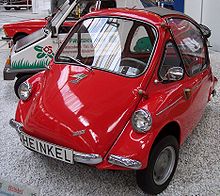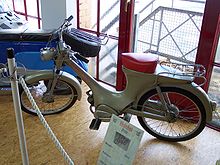Heinkel Flugzeugwerke - Picture

|
|
Heinkel
For the fictional character see Hainkeru.
Heinkel Flugzeugwerke was a German aircraft manufacturing company founded by and named after Ernst Heinkel. It is noted for producing bomber aircraft for the Luftwaffe in World War II and for important contributions to high-speed flight.
History
Heinkel was established at Warnemx¼nde in 1922 as the restrictions on German aviation imposed by the Treaty of Versailles were relaxed. The company's first great success was the design of the Heinkel He 70 Blitz high-speed mail plane and airliner for Deutsche Luft Hansa in 1932. The type broke a number of air speed records for its class and was followed by the two-engine Heinkel He 111 Doppel-Blitz. Heinkel's most important designers at this point were the twin Gx¼nter brothers, Siegfried and Walter, and Heinrich Hertel. The firm's headquarters was in Rostock, with an additional "Heinkel-Sud" facility in Schwechat, Austria, after the Anschluss in 1938.
The Heinkel company is most closely associated with aircraft used by the Luftwaffe during World War II. This began with the adaptation of the He 70 and, in particular, the He 111, to be used as bombers. In this role, the He 111 became a mainstay of the Luftwaffe. Heinkel also provided the Luftwaffe's only operational heavy bomber, the Heinkel He 177, although this was never deployed in significant numbers. The German Luftwaffe equipped both of these bombers with the Z-Gerx¤t, Y-Gerx¤t, and Knickebein, developed by Johannes Plendl, and thus they were among the first aircraft to feature advanced night navigation devices, common in all commercial airplanes today.
Heinkel was less successful in selling fighter designs - before the war, the Heinkel He 112 had been rejected in favour of the Messerschmitt Bf 109, and Heinkel's attempt to top Messerschmitt's design with the Heinkel He 100 failed due to political interference within the Reichsluftfahrtministerium (RLM - Reich Aviation Ministry). The company also provided the Luftwaffe with an outstanding night fighter, the Heinkel He 219, which also suffered from politics and was produced only in limited numbers.
From 1941 until the end of the war, the company was merged with engine manufacturer Hirth to form Heinkel-Hirth, giving the company the capability of manufacturing its own powerplants.
The Heinkel name was also behind pioneering work in jet engine and rocket development. In 1939, flown by Erich Warsitz, the Heinkel He 176 and Heinkel He 178 became the first aircraft to fly under liquid-fuel rocket and turbojet power respectively, and Heinkel was the first to develop a jet fighter to prototype stage, the Heinkel He 280. This latter aircraft never reached production however, since the RLM wanted Heinkel to concentrate on bomber production and instead promoted the development of the rival Messerschmitt Me 262. Very late in the war, a Heinkel jet fighter finally took to the air as the Heinkel He 162, but it had barely entered service at the time of Germany's surrender.
Following the war, Heinkel was prohibited from manufacturing aircraft and instead built bicycles, motor scooters (see below), and the Heinkel microcar. The company eventually returned to aircraft in the mid 1950s, licence building F-104 Starfighters for the West German Luftwaffe.
In 1965, the company was absorbed by Vereinigte Flugtechnische Werke (VFW), which was in turn absorbed by Messerschmitt-Bx¶lkow-Blohm in 1980.
Products
Aircraft
HD - Heinkel Doppeldecker
Heinkel HD 14
Heinkel HD 16
Heinkel HD 17
Heinkel HD 19
Heinkel HD 21
Heinkel HD 22
Heinkel HD 23
Heinkel HD 24 seaplane trainer (1926)
Heinkel HD 25
Heinkel HD 26
Heinkel HD 28
Heinkel HD 29
Heinkel HD 32
Heinkel HD 33
Heinkel HD 35
Heinkel HD 36
Heinkel HD 37 fighter (biplane)
Heinkel HD 38 fighter (biplane)
Heinkel HD 39
Heinkel HD 40
Heinkel HD 42 seaplane trainer
Heinkel HD 43 fighter (biplane)
HE - Heinkel Eindecker
Heinkel HE 1 low-wing floatplane (monoplane)
Heinkel HE 2 improvement on the HE 1
Heinkel HE 3
Heinkel HE 4 reconnaissance (monoplane)
Heinkel HE 5 reconnaissance (monoplane)
Heinkel HE 8 reconnaissance (monoplane)
Heinkel HE 9
Heinkel HE 12
Heinkel HE 18
Heinkel HE 37
Heinkel HE 38
He - Heinkel (RLM designator)
Heinkel He 45 bomber + trainer
Heinkel He 46 reconnaissance
Heinkel He 49 fighter (biplane)
Heinkel He 50 reconnaissance + dive bomber (biplane)
Heinkel He 51 fighter + close-support (biplane)
Heinkel He 57 Heron
Heinkel He 58
Heinkel He 59 reconnaissance (biplane seaplane)
Heinkel He 60 ship-borne reconnaissance (biplane seaplane)
Heinkel He 70 "Blitz" (Lightning), single-engine transport + mailplane, 1932
Heinkel He 72 Kadett (Cadet), trainer
Heinkel He 74 fighter + advanced trainer (prototype)
Heinkel He 100 fighter
Heinkel He 111 bomber
Heinkel He 112 fighter
Heinkel He 113 (fictitious alternative designation for He 100)
Heinkel He 114 reconnaissance seaplane
Heinkel He 115 general-purpose seaplane
Heinkel He 116 transport + reconnaissance
Heinkel He 117
Heinkel He 118
Heinkel He 119 single-engine high-speed bomber(prototypes), reconnaissance aircraft, 1937
Heinkel He 120 four-engine long-range passenger flying-boat(project), 1938
Heinkel He 162 "Salamander" Volksjx¤ger (People's Fighter), fighter (jet-engined)
Heinkel He 170
Heinkel He 172 trainer (prototype)
Heinkel He 176 pioneering liquid-fueled rocket powered experimental aircraft (prototype)
Heinkel He 177 Greif (Griffon), the Third Reich's only long-range heavy bomber
Heinkel He 178 world's pioneering jet-engined experimental aircraft
Heinkel He 219 Uhu (Owl), night-fighter
Heinkel He 270
Heinkel He 274 high-altitude bomber, He 177 development, two prototypes completed post-war in France
Heinkel He 277 heavy bomber, paper-only Amerika Bomber He 177 development with four individual radial engines, never built
Heinkel He 280 fighter (jet-engined)
Heinkel He 343 four-engined bomber (jet-engined) (project), 1944
Heinkel He 519, high-speed bomber (He 119 derivative)(project only), 1944
Heinkel Type 98 Medium Bomber
Heinkel Navy Type He Interceptor Fighter
Heinkel A7He
P - Projekt
Heinkel He P.1076, A nearly conventional 1944 design, with slightly forward swept wings and double propellers at the front.* Heinkel P.1077 Julia
Heinkel P.1078
Heinkel He P.1078A, fighter(jet-engined) (project)
Heinkel He P.1078B, tailless fighter(jet-engined) (project)
Heinkel He P.1078C, tailless fighter(jet-engined) (project), 1944
Heinkel He P.1079A, two-engine night-fighter(jet-engined) (project)
Heinkel He P.1079B/I, all-weather heavy fighter(flying wing design) (jet-engined)
Heinkel He P.1079B/II, all-weather heavy fighter(flying wing design) (jet-engined), 1945
Heinkel Lerche
Heinkel Wespe
Microcar

Picture - Heinkel Kabine
Heinkel introduced the "Kabine" bubble car in 1956. It competed with the BMW Isetta and the Messerschmitt KR200. It had a unit body and a four-stroke single-cylinder engine.
Heinkel stopped manufacturing the Kabine in 1958 but production continued under licence, first by Dundalk Engineering Company in Ireland and then by Trojan Cars Ltd., which ceased production in 1966.
Scooters

Picture - Heinkel Tourist 175 (1956)
Heinkel introduced the "Tourist" motor scooter in the 1950s. A large and relatively heavy touring machine, it provided good weather protection with a full fairing and the front wheel turning under a fixed nose extension. The "Tourist" had effective streamlining, perhaps unsurprising in view of its aircraft ancestry, and although it had only a 174 cc (10.6 cu in), 9.5 bhp 4-stroke engine, it was capable of sustaining speeds of up to 70 mph (official figures 58 mph), given time to get there.
The Heinkel scooter was known for its reliability.
Heinkel also made a lighter 150 cc (9.2 cu in) scooter called the Heinkel 150.
Mopeds

Picture - Heinkel Perle
Heinkel built the Perle moped from 1954 to 1957. The Perle was a sophisticated cycle with a cast alloy unit frame, rear suspension, a fully-enclosed chain with part of the chain enclosure integral with the swingarm, and interchangeable wheels. This high level of sophistication came at a high cost. Approximately twenty-seven thousand Perles were sold.
Maicoletta scooter, made by Maico
Zundapp 'Bella' scooter
Heinkel Pictures and Heinkel for Sale.
Living Warbirds: The best warbirds DVD series.
Source: WikiPedia